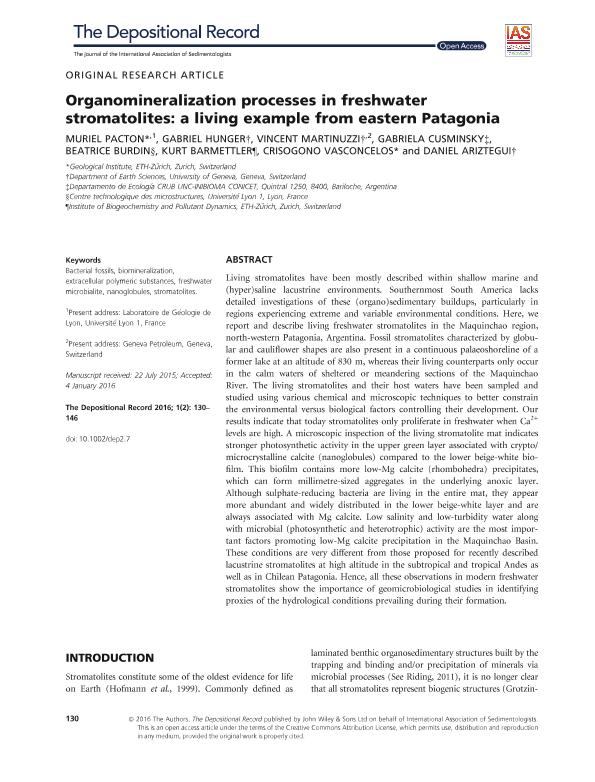Mostrar el registro sencillo del ítem
dc.contributor.author
Pacton, Muriel
dc.contributor.author
Hunger, Gabriel
dc.contributor.author
Martinuzzi, Vincent
dc.contributor.author
Cusminsky, Gabriela Catalina

dc.contributor.author
Burdin, Beatrice
dc.contributor.author
Barmettler, Kurt
dc.contributor.author
Vasconcelos, Crisogono
dc.contributor.author
Ariztegui, Daniel

dc.date.available
2018-09-26T15:45:16Z
dc.date.issued
2015-12
dc.identifier.citation
Pacton, Muriel; Hunger, Gabriel; Martinuzzi, Vincent; Cusminsky, Gabriela Catalina; Burdin, Beatrice; et al.; Organomineralization processes in freshwater stromatolites: a living example from eastern Patagonia; interntional Association of Sedimentology Wiley on line Library; The Depositional Record; 1; 2; 12-2015; 130-146
dc.identifier.issn
2055-4877
dc.identifier.uri
http://hdl.handle.net/11336/60886
dc.description.abstract
Living stromatolites have been mostly described within shallow marine and (hyper)saline lacustrine environments. Southernmost South America lacks detailed investigations of these (organo)sedimentary buildups, particularly in regions experiencing extreme and variable environmental conditions. Here, we report and describe living freshwater stromatolites in the Maquinchao region, north‐western Patagonia, Argentina. Fossil stromatolites characterized by globular and cauliflower shapes are also present in a continuous palaeoshoreline of a former lake at an altitude of 830 m, whereas their living counterparts only occur in the calm waters of sheltered or meandering sections of the Maquinchao River. The living stromatolites and their host waters have been sampled and studied using various chemical and microscopic techniques to better constrain the environmental versus biological factors controlling their development. Our results indicate that today stromatolites only proliferate in freshwater when Ca2+ levels are high. A microscopic inspection of the living stromatolite mat indicates stronger photosynthetic activity in the upper green layer associated with crypto/microcrystalline calcite (nanoglobules) compared to the lower beige‐white biofilm. This biofilm contains more low‐Mg calcite (rhombohedra) precipitates, which can form millimetre‐sized aggregates in the underlying anoxic layer. Although sulphate‐reducing bacteria are living in the entire mat, they appear more abundant and widely distributed in the lower beige‐white layer and are always associated with Mg calcite. Low salinity and low‐turbidity water along with microbial (photosynthetic and heterotrophic) activity are the most important factors promoting low‐Mg calcite precipitation in the Maquinchao Basin. These conditions are very different from those proposed for recently described lacustrine stromatolites at high altitude in the subtropical and tropical Andes as well as in Chilean Patagonia. Hence, all these observations in modern freshwater stromatolites show the importance of geomicrobiological studies in identifying proxies of the hydrological conditions prevailing during their formation.
dc.format
application/pdf
dc.language.iso
eng
dc.publisher
interntional Association of Sedimentology Wiley on line Library
dc.rights
info:eu-repo/semantics/openAccess
dc.rights.uri
https://creativecommons.org/licenses/by/2.5/ar/
dc.subject
Bacterial Fossils
dc.subject
Biomineralization
dc.subject
Extracellular Polimeric Susbtance
dc.subject
Freshwater Microbialite
dc.subject
Nanoglobules
dc.subject
Stromatolites
dc.subject.classification
Meteorología y Ciencias Atmosféricas

dc.subject.classification
Ciencias de la Tierra y relacionadas con el Medio Ambiente

dc.subject.classification
CIENCIAS NATURALES Y EXACTAS

dc.title
Organomineralization processes in freshwater stromatolites: a living example from eastern Patagonia
dc.type
info:eu-repo/semantics/article
dc.type
info:ar-repo/semantics/artículo
dc.type
info:eu-repo/semantics/publishedVersion
dc.date.updated
2018-09-24T14:14:09Z
dc.journal.volume
1
dc.journal.number
2
dc.journal.pagination
130-146
dc.journal.pais
Bélgica

dc.journal.ciudad
Gent
dc.description.fil
Fil: Pacton, Muriel. Geological Institute; Suiza
dc.description.fil
Fil: Hunger, Gabriel. Universidad de Ginebra; Suiza
dc.description.fil
Fil: Martinuzzi, Vincent. Universidad de Ginebra; Suiza
dc.description.fil
Fil: Cusminsky, Gabriela Catalina. Consejo Nacional de Investigaciones Científicas y Técnicas. Centro Científico Tecnológico Conicet - Patagonia Norte. Instituto de Investigaciones en Biodiversidad y Medioambiente. Universidad Nacional del Comahue. Centro Regional Universidad Bariloche. Instituto de Investigaciones en Biodiversidad y Medioambiente; Argentina
dc.description.fil
Fil: Burdin, Beatrice. Centre technologique des microstructures; Francia
dc.description.fil
Fil: Barmettler, Kurt. Institute of Biogeochemistry and Pollutant Dynamics; Suiza
dc.description.fil
Fil: Vasconcelos, Crisogono. Geological Institute; Suiza
dc.description.fil
Fil: Ariztegui, Daniel. Universidad de Ginebra; Suiza
dc.journal.title
The Depositional Record
dc.relation.alternativeid
info:eu-repo/semantics/altIdentifier/doi/https://dx.doi.org/10.1002/dep2.7
dc.relation.alternativeid
info:eu-repo/semantics/altIdentifier/url/https://onlinelibrary.wiley.com/doi/abs/10.1002/dep2.7
Archivos asociados
